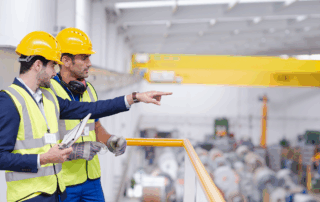FALL PROTECTION SAFETY
Fall protection and safety is a major concern at construction sites. In fact, OSHA cites injuries from falls as one of its top 10 worksite injuries.
Falls and falling objects can result from unstable working surfaces, ladders that are not safely positioned and misuse of fall protection. Workers are also subject to falls or the dangers of falling objects if sides and edges, floor holes and wall openings are not protected. Any time you are working at a height of six feet or more on the construction site, you must be protected.
Unprotected Sides, Wall Openings and Floor Holes
Almost all sites have unprotected sides and edges, wall openings or floor holes at some point during construction. If these sides and openings are not protected, injuries from falls or falling objects may result. Use at least one of the following whenever you are exposed to a fall of six feet or more above a lower level:
- Guardrail systems
- Safety net systems
- Fall arrest systems
Additional Safety Precautions
- Cover or guard floor holes promptly after creating them.
- Construct floor hole covers so they will effectively support two times the weight of workers, equipment and materials that may be imposed on the cover at any one time.
- Use fall prevention systems like guardrails rather than protection systems like safety nets or fall arrest devices.
Ladders
You also increase your chances of falling if you are using portable ladders that are not safely positioned each time you use them. While you are on a ladder, it may move or slip from its supports. You may also lose your balance while getting on and off an unsteady ladder.
Take the following fall protection measures when using ladders:
- Position portable ladders so side rails extend at least three feet above the landing.
- Secure side rails at the top to a rigid support and use a grab device when a three foot extension is not possible.
- Make sure that the weight on the ladder will not cause it to slip off its support.
- Inspect ladders for cracked, broken or defective parts prior to each use. If a ladder is broken, tag it as defective and remove it from service.
- Don’t apply more weight on a ladder than it is designed to support.
- Only use ladders that comply with OSHA standards.
About the Author
Share This Story
Related Blogs
OSHA Announces Top 10 Violations for 2025
OSHA recently revealed its top 10 most frequently cited standards in the 2025 fiscal year using preliminary data. This information is valuable for businesses of all kinds, as it helps them identify common exposures that affect their workforce and gives them the information they need to plan their compliance programs.
Cyber Hygiene for Schools: Teaching Digital Safety to Students
Cyber hygiene for schools is more important than ever in today’s digital learning environment. Teaching digital safety to students not only protects their personal information but also strengthens overall school cybersecurity. With increasing online access in classrooms, cyber hygiene for schools must become a routine part of curriculum planning and student behavior expectations.
Mental Health Benefits Go Mainstream: What Employers Need to Know
Once considered a niche offering or a reactive add-on, mental health benefits have now moved to the center of the employee experience. In 2025, nearly half of U.S. employers offer some form of mental health support beyond traditional EAPs—a sharp rise from just 30% in 2023. This shift isn’t just cultural; it’s strategic.








